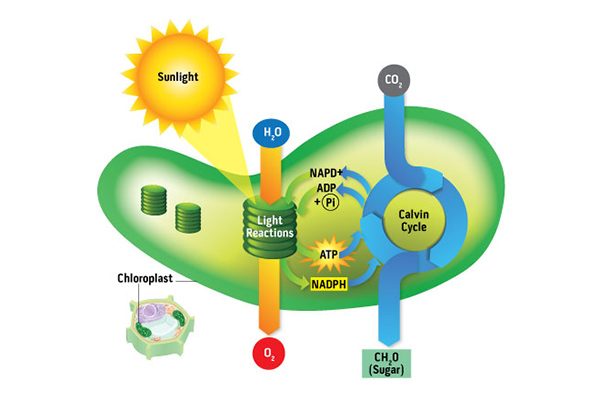Origin: a Latin derivative
meaning "Gift of the Earth."
Part 5: Plant Metabolism—Photosynthesis

The cells of all living creatures are undergoing continuous chemical reactions that sustain life. The sum of these chemical reactions is called metabolism. Since plants cannot move around to gather food like humans and animals, they must produce their own energy using a set of specific chemical reactions, collectively known as photosynthesis. The photosynthetic process can be summarized by the following equation:
Several anatomical parts of the plant are involved in photosynthesis. Leaves absorb sunlight and also house chloroplasts where the actual process of photosynthesis takes place. Leaves are also where gas exchange occurs. Plants “breathe” in a way opposite that we do; they bring in carbon dioxide and release oxygen. Roots absorb water and then the intricate conducting system housed within the stem and branches allow the water to makes its way to the leaves. Once all of the necessary components (water, carbon dioxide, and solar energy) combine, photosynthesis can proceed.
Complex Reactions
Although the above reaction may seem simple, photosynthesis actually involves a series of two complex reactions: light reactions and the Calvin cycle. Both processes occur in chloroplasts. The light reactions use light energy (absorbed by green chlorophyll pigments) and H2O to make chemical energy in the form of adenosine triphosphate (ATP) and nicotinamide adenine dinucleotide phosphate (NADPH) with oxygen (O2) being released as a byproduct. When light hits the pigments inside of the chloroplasts, electrons become “excited”, meaning they are now energized. Some of this energy works to break apart water molecules. The oxygen (O from the H2O) is released into the atmosphere for use by other living organisms. Another portion of the energy attaches the hydrogens (H from the H2O) to NADP to form NADPH. NADPH is an energy-carrying molecule that provides energy needed by other reactions. The rest of the energy is incorporated into another high-energy molecule called ATP that is also used to power additional reactions. In the Calvin cycle, three-carbon sugars are assembled using the CO2 from the air and energy from the ATP and NADPH molecules assembled in the light reactions. These three-carbon simple sugars can then be used to make more complex sugars like glucose (a six carbon sugar).





